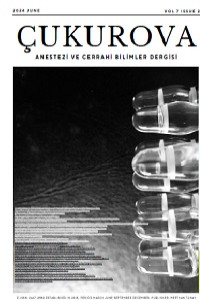Abstract
References
- 1. Allegranzi B, Bischoff P, de Jonge S, Kubilay NZ, Zayed B, Gomes SM, ve ark. New WHO recommendations on preoperative measures for surgical site infection prevention: an evidence-based global perspective. Lancet Infect Dis. 2016;16(12):e276-e287.
- 2. Alemkere G. Antibiotic usage in surgical prophylaxis: A prospective observational study in the surgical ward of Nekemte referral hospital. PloS one. 2018;13(9):e0203523.
- 3. Bartella AK, Lemmen S, Burnic A, Kloss-Brandsätter A, Kamal M, Breisach T, ve ark. Influence of a strictly perioperative prophylaxis vs a prolonged postoperative prophylaxis on surgical site infections in maxillofacial surgery. Infection. 2018;46(2):225-230.
- 4. Dogan CZ. Evaluation of the appropriateness of prophylactic antimicrobial use in general surgery patients [Specialization thesis]. Ankara: Hacettepe Üniversitesi; 2023.
- 5. Bratzler DW, Dellinger EP, Olsen KM, Perl TM, Auwaerter PG, Bolon MK, ve ark. Clinical practice guidelines for antimicrobial prophylaxis in surgery. Am J Health-Syst Pharm. 2013;70:195-283.
- 6. Karaali C, Emiroglu M, Esin H, Sert I, Aydın C, Atalay S. Assessment of prophylactic antibiotic usage habits of the general surgeons in Turkey. J Infect Dev Ctries. 2020;14(7):758-764.
- 7. Kuhnen RB, Sabino Neto M, Souza LV, Ferreira LM, Veiga DF. Antibiotic Prophylaxis in Reduction Mammaplasty: A National Survey. Aesthetic Plast Surg. 2022;46(5):2124-2130.
- 8. Pelullo CP, Pepe A, Napolitano F, Coppola N, Di Giuseppe G. Perioperative antibiotic prophylaxis: knowledge and attitudes among resident physicians in Italy. Antibiotics. 2020;9(6):357.
- 9. Santoshi JA, Behera P, Nagar M, Sen R, Chatterjee A. Current surgical antibiotic prophylaxis practices: a survey of orthopaedic surgeons in India. Ind
- 10. MacCormick AP, Akoh JA. Survey of surgeons regarding prophylactic antibiotic use in inguinal hernia repair. Scand J Surg. 2018;107(3):208-211.
- 11. Ghuman A, Karimuddin AA, Brown CJ, Raval MJ, Phang PT. Colorectal surgery surgical site infection prevention practices in British Columbia. Can J Surg. 2021;64(5):516-520.
Evaluation of General Surgery Physicians' Approaches to Surgical Antimicrobial Prophylaxis by Questionnaire Method
Abstract
Introduction: Surgical site infections (SSIs) are infections of the incision site, organ or cavity that occur after surgery, causing a significant burden in terms of morbidity, mortality and healthcare costs. SSIs are the most common healthcare-associated infections in low- and middle-income countries and may affect one-third of surgical patients. This study aimed to conduct a face-to-face survey to evaluate general surgeons' approaches and knowledge levels before and after the training seminar on the use of surgical antimicrobial prophylaxis (SAP).
Material and Method: An information-oriented questionnaire consisting of 10 questions was administered to a total of 18 surgeons working a General Surgery Department before and after the education meeting to evaluate their knowledge and attitudes towards the use of SAP. Data were presented as number, percentage, mean (standard deviation) and Fisher exact test was used to compare categorical data.
Results: All participants answered the question regarding the time of prophylactic antibiotic administration correctly in both surveys. According to the current American Society of Health-System Pharmacists (ASHP) guideline for cefazolin, 42.2% of the patients had the correct time of antibiotic administration. The proportion of patients whose cefazolin selection, dose and time of administration were appropriate was 14.6%. The number of physicians who thought that postoperative antibiotic prophylaxis was not significantly increased from 16 (88.8%) before the meeting to 18 (100%) after the meeting (p>0.05). In our study, the number of patients who continued to be given antibiotics unnecessarily postoperatively was 66 (16.4%).
Conclusion: In order to increase the rate of optimal application of the theoretical knowledge to patients in practice, it is important to organize routine trainings based on current literature and service data for surgeons with a high workload and to follow the reflection of these trainings to the clinic in order to improve SAP compliance rates.
Keywords
Surgical antimicrobial prophylaxis general surgery survey surgical site infection guideline
References
- 1. Allegranzi B, Bischoff P, de Jonge S, Kubilay NZ, Zayed B, Gomes SM, ve ark. New WHO recommendations on preoperative measures for surgical site infection prevention: an evidence-based global perspective. Lancet Infect Dis. 2016;16(12):e276-e287.
- 2. Alemkere G. Antibiotic usage in surgical prophylaxis: A prospective observational study in the surgical ward of Nekemte referral hospital. PloS one. 2018;13(9):e0203523.
- 3. Bartella AK, Lemmen S, Burnic A, Kloss-Brandsätter A, Kamal M, Breisach T, ve ark. Influence of a strictly perioperative prophylaxis vs a prolonged postoperative prophylaxis on surgical site infections in maxillofacial surgery. Infection. 2018;46(2):225-230.
- 4. Dogan CZ. Evaluation of the appropriateness of prophylactic antimicrobial use in general surgery patients [Specialization thesis]. Ankara: Hacettepe Üniversitesi; 2023.
- 5. Bratzler DW, Dellinger EP, Olsen KM, Perl TM, Auwaerter PG, Bolon MK, ve ark. Clinical practice guidelines for antimicrobial prophylaxis in surgery. Am J Health-Syst Pharm. 2013;70:195-283.
- 6. Karaali C, Emiroglu M, Esin H, Sert I, Aydın C, Atalay S. Assessment of prophylactic antibiotic usage habits of the general surgeons in Turkey. J Infect Dev Ctries. 2020;14(7):758-764.
- 7. Kuhnen RB, Sabino Neto M, Souza LV, Ferreira LM, Veiga DF. Antibiotic Prophylaxis in Reduction Mammaplasty: A National Survey. Aesthetic Plast Surg. 2022;46(5):2124-2130.
- 8. Pelullo CP, Pepe A, Napolitano F, Coppola N, Di Giuseppe G. Perioperative antibiotic prophylaxis: knowledge and attitudes among resident physicians in Italy. Antibiotics. 2020;9(6):357.
- 9. Santoshi JA, Behera P, Nagar M, Sen R, Chatterjee A. Current surgical antibiotic prophylaxis practices: a survey of orthopaedic surgeons in India. Ind
- 10. MacCormick AP, Akoh JA. Survey of surgeons regarding prophylactic antibiotic use in inguinal hernia repair. Scand J Surg. 2018;107(3):208-211.
- 11. Ghuman A, Karimuddin AA, Brown CJ, Raval MJ, Phang PT. Colorectal surgery surgical site infection prevention practices in British Columbia. Can J Surg. 2021;64(5):516-520.
Details
| Primary Language | English |
|---|---|
| Subjects | General Surgery, Infectious Diseases |
| Journal Section | Articles |
| Authors | |
| Publication Date | June 30, 2024 |
| Submission Date | April 15, 2024 |
| Acceptance Date | June 24, 2024 |
| Published in Issue | Year 2024 Volume: 7 Issue: 2 |

